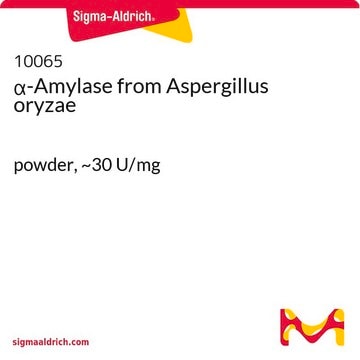A7130
β-Amylase from barley
Type II-B, 20-80 units/mg protein (biuret)
Sinónimos:
1,4-α-D-Glucan maltohydrolase
About This Item
Productos recomendados
type
Type II-B
form
powder
specific activity
20-80 units/mg protein (biuret)
greener alternative product characteristics
Waste Prevention
Design for Energy Efficiency
Learn more about the Principles of Green Chemistry.
sustainability
Greener Alternative Product
greener alternative category
, Enabling
shipped in
wet ice
storage temp.
2-8°C
¿Está buscando productos similares? Visita Guía de comparación de productos
General description
Application
Biochem/physiol Actions
Quality
Unit Definition
Other Notes
signalword
Danger
hcodes
pcodes
Hazard Classifications
Resp. Sens. 1
Storage Class
11 - Combustible Solids
wgk_germany
WGK 3
flash_point_f
Not applicable
flash_point_c
Not applicable
ppe
dust mask type N95 (US), Eyeshields, Faceshields, Gloves
Certificados de análisis (COA)
Busque Certificados de análisis (COA) introduciendo el número de lote del producto. Los números de lote se encuentran en la etiqueta del producto después de las palabras «Lot» o «Batch»
¿Ya tiene este producto?
Encuentre la documentación para los productos que ha comprado recientemente en la Biblioteca de documentos.
Los clientes también vieron
Protocolos
Beta-amylase is found in bacteria, fungi, and plants. To measure β-amylase activity, this assay uses a colorimetric spectrophotometric stop reaction at 540 nm.
Beta-amylase is found in bacteria, fungi, and plants. To measure β-amylase activity, this assay uses a colorimetric spectrophotometric stop reaction at 540 nm.
Beta-amylase is found in bacteria, fungi, and plants. To measure β-amylase activity, this assay uses a colorimetric spectrophotometric stop reaction at 540 nm.
Beta-amylase is found in bacteria, fungi, and plants. To measure β-amylase activity, this assay uses a colorimetric spectrophotometric stop reaction at 540 nm.
Nuestro equipo de científicos tiene experiencia en todas las áreas de investigación: Ciencias de la vida, Ciencia de los materiales, Síntesis química, Cromatografía, Analítica y muchas otras.
Póngase en contacto con el Servicio técnico











